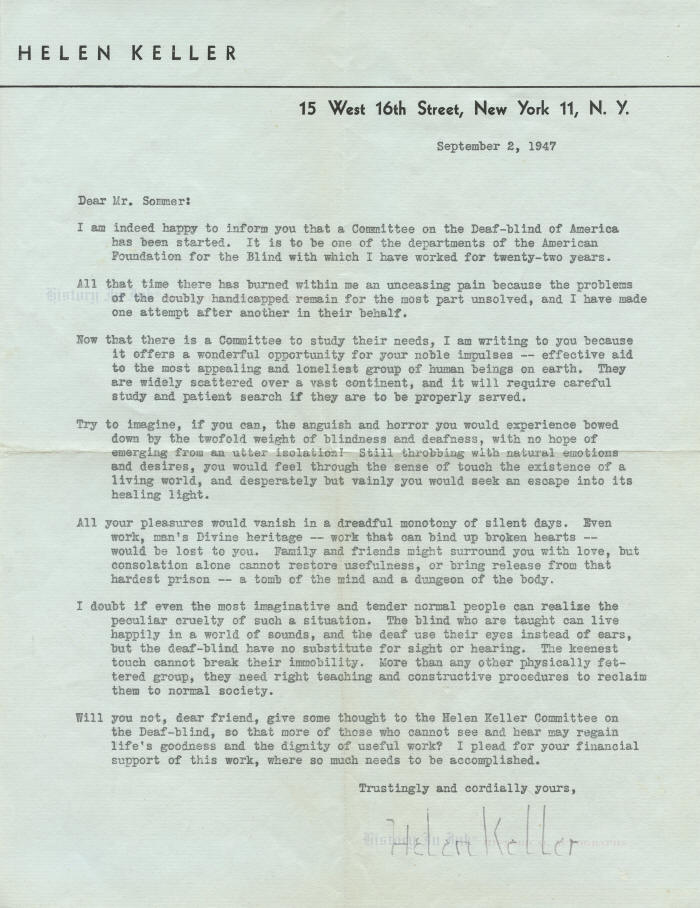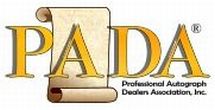2105904
Helen Keller
Scroll down to see images of the item below the description
“Try to imagine . . . the anguish and horror you would experience
bowed down by the twofold weight of blindness and deafness,
with no hope of emerging from an utter isolation!”
Helen Adams Keller, 1880–1968. American disability rights activist and author. Typed letter signed, Helen Keller, one page, 8¼” x 10¾”, on personal stationery, New York, New York, September 2, 1947.
This is an extraordinary letter in which Keller, who was both deaf and blind, graphically describes the stifling world of those who suffer from the dual disability, whom she calls “the most appealing and loneliest group of human beings on earth.” Seeking to raise funds for the Helen Keller Committee on the Deaf-blind, she writes, in part: “Try to imagine . . . the anguish and horror you would experience bowed down by the twofold weight of blindness and deafness, with no hope of emerging from an utter isolation! Still throbbing with natural emotions and desires, you would feel through the sense of touch the existence of a living world, and desperately but vainly you would seek an escape into its healing light. / All your pleasures would vanish in a dreadful monotony of silent days. Even work, man’s Divine heritage—work that can bind up broken hearts—would be lost to you. Family and friends might surround you with love, but consolation alone cannot restore usefulness, or bring release from that hardest prison—a tomb of the mind and a dungeon of the body. / I doubt if even the most imaginative and tender normal people can realize the peculiar cruelty of such a situation. The blind who are taught can live happily in a world of sounds, and the deaf can use their eyes instead of ears, but the deaf-blind have no substitute for sight or hearing. The keenest touch cannot break their immobility.”
Keller lost her sight and hearing when she was some 19 months old. She suffered from an illness that her doctor diagnosed as “acute congestion of the stomach and the brain.” Modern medical experts speculate that she might have contracted meningitis, rubella, or scarlet fever. Regardless, Keller described her life as being “at sea in a dense fog.” Helen Keller, The Story of My Life 21 (John Albert Macy ed., 1921). She was examined by physicians and finally by Alexander Graham Bell, the inventor of the telephone, who worked with deaf children. Bell referred her parents to the Perkins Institute for the Blind.
The school arranged for one of its former students, Anne Sullivan, who was also visually impaired, to work with Keller. When she met Sullivan, Keller said, “the light of love shone on me in that very hour.” Id. at 22. Sullivan taught Keller to communicate by spelling words into her hand with sign language, which Keller at first did not understand but eventually began to emulate and then to associate with items that Sullivan would have her touch. Keller described in her autobiography her realization of what Sullivan was doing when she placed Keller’s hand under the spout of the well house pump:
As the cool stream gushed over one hand she spelled into the other the word water, first slowly, then rapidly. I stood still, my whole attention fixed upon the motions of her fingers. Suddenly I felt a misty consciousness as of something forgotten—a thrill of returning thought; and somehow the mystery of language was revealed to me. I knew then that “w-a-t-e-r” meant the wonderful cool something that was flowing over my hand. That living word awakened my soul, gave it light, hope, joy, set it free!
Id. at 23. With Sullivan’s help, Keller learned both to read and to write. She also learned how to speak and understand other people’s speech. Thus Keller’s insistence in this letter that “the doubly handicapped” deaf-blind “need right teaching and constructive procedures to reclaim them to normal society.”
This letter is generally clean and bright. It has single intersecting horizontal and vertical mailing folds, neither of which affects Keller’s pencil signature, and there are old dealer pencil notations on the back. The letter is in fine condition.
Unframed.







